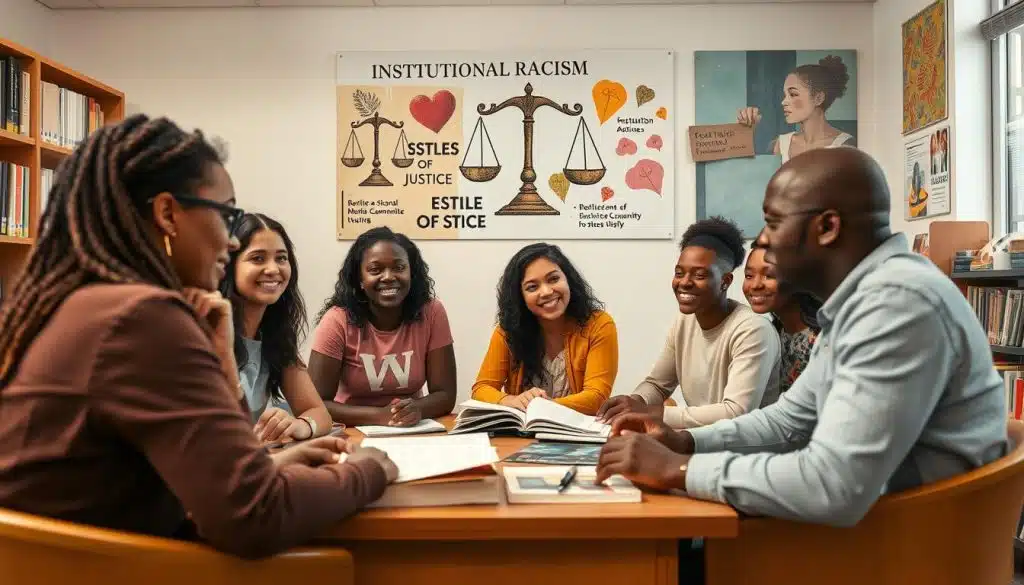Did you know that less than 5% of all items released annually by the Association of Social Work Boards (ASWB) show tendencies of Differential Item Functioning (DIF), a type of bias in the social work licensing exam? This statistic shows how hard the ASWB works to make the exam fair. It ensures that aspiring social workers are judged based on their skills, not their background.
It’s important for social workers to know about the different biases that can affect the ASWB exam. These biases also impact social work practice. By understanding these biases, we can make our profession more welcoming and fair for everyone.
Institutional racism is a big problem in social work, even though the field fights against discrimination. It’s not about being mean on purpose. Instead, it’s about deep, hidden biases in how we work and learn. This idea comes from sociology, which sees big systems as part of the problem.
Institutional racism in social work is hard to spot because it’s not obvious. It’s been talked about since the 1960s. The field is trying to understand institutional racism, implicit bias, and how to be more culturally competent.
Institutional racism affects social work education a lot. It can hold back students from different backgrounds. To fix this, we need to work together to make real changes.
It’s hard to figure out how much institutional racism exists in social work. Getting accurate data is tough because people don’t always share their background. But, the ASWB’s move to share exam results by group is a big step forward.

“The value of high-quality, equity-informed supervision is highlighted as a key factor in promoting positive change in social work.”
As social workers, it’s key to know about different biases that can affect our work. This includes implicit and explicit biases, as well as cultural and gender-based ones. Recognizing these is vital for fair and inclusive services in order to prevent bias social work.
Bias in social work can significantly impact the effectiveness of practice and the well-being of clients. One prevalent example of bias in social work is racial bias, where social workers may unconsciously treat clients differently based on their racial or ethnic background. This can lead to disparities in service provision, such as accessing resources or receiving adequate support. Another common example of bias in social work is socioeconomic bias, where assumptions about a client’s financial status can shape the way a social worker interacts with them. For instance, a worker might inadvertently perceive a low-income client as less motivated to improve their situation, which can hinder rapport-building and support.
Gender bias is also an issue in social work; it can manifest in the way workers address issues related to domestic violence or child custody. Female clients may be viewed through a lens that either exaggerates or diminishes their agency, affecting the support they receive. Conversely, male clients suffering from victimization may be seen as less credible or deserving of help. These examples of biases in social work not only affect individual client interactions but can also have far-reaching implications for the systems and structures in which social workers operate.
To address these biases, it is essential for social workers to engage in continuous self-reflection and education. Understanding one’s own potential biases is the first step in mitigating their impact. Workshops focused on cultural competence and anti-oppressive practices can provide invaluable insights into how to overcome personal bias in social work. Additionally, seeking supervision and feedback from peers allows social workers to challenge their perspectives and assumptions, fostering an environment of accountability and growth.
Ultimately, recognizing and addressing examples of personal biases in social work is crucial in providing equitable and effective support to clients. It requires a commitment to personal and professional development, along with a willingness to listen, learn, and adapt. By prioritizing the reduction of bias, social workers can better serve diverse populations and promote social justice in their communities.
Bias in social work assessment can significantly impact the effectiveness of interventions and the quality of services provided to clients. Social workers, like all individuals, may hold implicit biases—attitudes or stereotypes that unconsciously affect their understanding, actions, and decisions. Implicit bias in social work can manifest in various forms, influencing how practitioners interact with diverse clients and shaping their assessment processes. Recognizing these biases is crucial for social workers striving to deliver equitable services and foster positive outcomes for the individuals, families, and communities they serve.
Understanding the implications of implicit bias social work can help practitioners become more self-aware and critically evaluate their practices. Training programs that focus on identifying and mitigating implicit biases are increasingly being integrated into social work education and professional development. These initiatives aim to enhance awareness of biases that might distort assessments, treatment plans, and interactions, ultimately empowering social workers to provide more culturally competent care. By engaging in reflective practices, social workers can challenge their own assumptions and promote an inclusive environment that respects and values diverse perspectives and experiences.
Addressing bias in social work assessment not only improves service delivery but also fosters trust between social workers and clients. When clients feel understood and respected, they are more likely to engage fully in the therapeutic process, leading to better outcomes. To overcome the effects of implicit bias, social workers can adopt evidence-based practices that prioritize client strengths and emphasize collaborative decision-making. This commitment to equity not only strengthens the profession’s integrity but also reinforces the core values central to social work—social justice, dignity, and the worth of all individuals.
Ultimately, combating implicit bias in social work practice requires ongoing education, self-reflection, and a willingness to confront uncomfortable truths about one’s biases and privileges. By fostering a critical consciousness around bias in social work assessment, practitioners can create a more just and equitable system that serves all clients effectively. Efforts to mitigate implicit bias must be woven into the very fabric of social work practice, ensuring that the profession continues to evolve and meet the needs of a diverse population.
Gender bias is a pervasive issue that can infiltrate various professional fields, and social work is no exception. Within this discipline, practitioners are tasked with advocating for the most vulnerable populations, yet they can sometimes unintentionally perpetuate gender stereotypes in their assessments and interventions. An example of bias in social work can be particularly evident in how practitioners perceive and interact with clients based on their gender. For instance, a case involving a female client experiencing domestic violence might be approached with underlying assumptions that she is passive or dependent, while a male client exhibiting similar issues might be viewed through a lens of aggression or responsibility. Such biases not only affect the treatment outcomes but can also reinforce harmful stereotypes in the clients’ perceptions of themselves.
Addressing gender bias in social work requires a multifaceted approach that emphasizes training and awareness. Social workers must engage in ongoing education about gender dynamics, challenge their own biases, and foster empathy towards clients regardless of their gender. Furthermore, mentorship programs and supervision should include discussions about gender bias in practice, encouraging professionals to reflect on their own biases and the systemic barriers that exist within the field. By consciously working to mitigate gender bias in social work assessments and interventions, practitioners can provide more equitable and effective support to all clients, ultimately leading to better outcomes for those they serve.
Cultural biases are deeply ingrained perceptions that can affect interpersonal relations and decision-making in various professional fields, including social work. In this context, cultural bias refers to the tendency to interpret and judge situations, behaviors, and values through the lens of one’s own cultural background, potentially leading to misguided assumptions about clients. This is particularly concerning in social work, where practitioners are tasked with understanding and addressing the unique needs of diverse populations. Cultural bias in social work can hinder effective communication, compromise the quality of care, and perpetuate systemic inequalities.
It’s crucial to recognize our personal biases and how they mix with our work. This means reflecting on ourselves, getting feedback, and learning more about different cultures. The ASWB exam might test our ability to spot and deal with our biases in a professional setting.

Understanding different biases and their effects on social work helps us prepare for the ASWB exam. It also helps us provide better services to our communities.
Confirmation bias in social work is a cognitive phenomenon where individuals tend to favor information that confirms their existing beliefs while disregarding evidence that contradicts them. This bias can significantly impact various fields, including social work, where professionals are tasked with making decisions that affect the lives of vulnerable populations. In the context of social work, confirmation bias social work can lead practitioners to focus only on information that aligns with their preconceived notions about clients or communities, which can ultimately affect the quality and effectiveness of the support they provide.
To mitigate the effects of confirmation bias, it is essential for social workers to actively engage in reflective practices. This involves regularly examining their own beliefs and assumptions and seeking out perspectives that challenge their viewpoints. Peer supervision and ongoing education can also play a critical role in helping individuals recognize their biases and understand the broader context of their work. Understanding how to manage personal bias in social work requires commitment and openness to change, allowing practitioners to provide more accurate assessments and support for their clients.
As social workers, we must face and tackle the biases that creep into our work. It’s critical to overcome personal bias in social work and manage bias in social work. We need to boost cultural competency in social work to offer fair and just services. Let’s look at some important ways to tackle bias in our field.
First, we need to assess ourselves for bias. Use proven tools and methods to find out our biases. This self-check can include bias tests, deep thinking, and feedback from others.
By understanding our biases, we can work to reduce their impact on our work. This helps us make better choices and interact more effectively with others.
Building cultural competency is crucial to fight bias in social work. It means learning more about different cultures and experiences. Take part in training, workshops, and talks with peers to grow your cultural awareness.
Also, work with community groups and listen to those who are often overlooked. This way, we can better serve our clients and work towards fairness for all.
Using a strong ethical framework helps us deal with bias in tough situations. Learn and follow professional ethics rules. Think deeply about your choices and talk to others when needed.
By sticking to high ethical standards, we ensure our work is fair and just. This way, we respect everyone we serve.
By using these strategies, we can make our social work field more inclusive and fair. Through self-checks, learning about cultures, and making ethical choices, we can beat personal and system biases. This way, we give the best care to our communities.
Dealing with bias in social work and on the ASWB exam is a big task. It needs constant learning, self-awareness, and growth. The ASWB exam tries to avoid bias, and social work education is getting better at tackling racism.
Future social workers must be ready to face and solve social work bias awareness issues. This starts with ASWB exam preparation and goes on through their ethical social work practice.